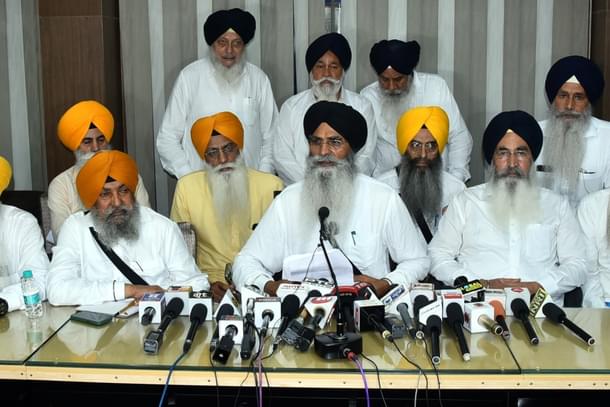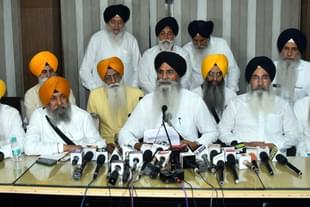Politics
Supreme Court Allows Haryana To Set Up A Separate Gurdwara Management Committee—What Will SGPC Do Now?
Rohit Pathania
Sep 26, 2022, 12:51 PM | Updated 12:51 PM IST
Save & read from anywhere!
Bookmark stories for easy access on any device or the Swarajya app.


In what can be explained by the term 'historic', the Supreme Court rejected the appeal of the Shiromani Gurdwara Parbandhak Committee (SGPC) challenging the 2014 order of the Haryana government that set up a separate state-level Gurdwara Management Committee, and took the control of Gurdwaras in Haryana away from SGPC.
Till that time, Gurdwaras of Punjab, Haryana and Himachal Pradesh were administered directly by the SGPC as per the SGPC Act 1925.
The Act was a culmination of a years long struggle led by the Akali Dal to get control of Gurdwaras and "restore" Sikhism to its pristine original form, free of "corruptions" brought in by the mahants who controlled them. The SGPC has sought a review of the order, and even decried the decision by calling it an "attack" on the "soul of the Khalsa Panth".
The SGPC has been seeking to gain control on all important Gurdwaras across the country. It sought to get people associated with it elected across the various management bodies of these Gurdwaras, and gaining a degree of traction too in the process.
Of course, it has also faced blowback, with questions being raised on the interference in liturgy being sought in places like Hazur Saheb Nanded and Patna Sahib to make it more in line with the SGPC's defined tenets of Sikhism. That in fact has been a major criticism over the years too.
The matter is not of recent origin - the SGPC and Akali Dals of various hues have always demanded the control of Gurdwaras historically. To that extent, the Anandpur Sahib Resolution sought an all-India Gurdwara committee that would be run much on the lines of the SGPC. Not having the control on Gurdwaras was seen as a matter of much grievance by the likes of Master Tara Singh and Sant Fateh Singh even earlier.
This is perfectly in line with the claim that the SGPC and the Akali Dal (Badal), the present faction controlling it, have always tried to maintain - of being the sole representative of all Sikhs in matters both temporal and spiritual.
Often, control of the SGPC in the past was also demonstrated as affirmation of the Akali Dal being the sole representative of the Sikhs, much as it happens today, even if the political arena showed results otherwise. Indeed, other groups have usually failed to gain control on the SGPC or even the Delhi Sikh Gurdwara Management Committee (DSGMC), as the contests get reduced to name-calling, with parties resorting to call each other traitors to the panth and the cause, 'government sellouts', and 'fraud Sikhs' among other things.
For that matter, even steps like disenfranchising Sehajdhari Sikhs from voting for SGPC elections was a step for perpetuating the control of the Akali Dal (Badal).
Much Ado About Money
Much of this stormy discussion today of course ends up skirting something absolutely critical about the real issue around it. Haryana formed a significant portion of the finances of the SGPC, which will slip out of its hands now. This would be a hit to the SGPC, which has always sought to be the sole determiner of how donations are to be utilised.
Control on the chadhava or the donations to the Guru Gollak has been a matter of much debate and even altercations, be it in Indian Gurdwaras as was seen in Faridkot recently or in the Sikh diaspora abroad, with the Brisbane Gurdwara fight of 2021 serving as the latest example of more of the same.
While the SGPC is empowered to decide how the money is utilised, questions have arisen on the purpose to which the deployment happened.
After gaining control via the SGPC, the Akali Dal used to deploy the money for Dharam Parchaar. However, post independence, the funds were also utilised to power the political activities of the Akali Dal under Master Tara Singh.
In recent times, there have been severe accusations, from people stealing from the Guru Gollak to corrupt practices like questionable appointments by creating useless positions just to provide patronage. Having the power of all forms of executive, the SGPC also remains immune to external scrutiny, leading to much angst among a significant section of the Sikh community today.
This angst surfaces in the form of protests on a variety of issues, be it be-adbi allegations or the missing saroops.
Watch Out For What Happens Next
Of particular interest would be to see what happens to the Badal family now. They have vehemently protested against the order, and have been rather vocal about it. This is as much a battle of survival for them, given how the SGPC remains their last standing bastion.
Attempts to rally the panth behind them have failed more than once - the Bandi Singh movement is going nowhere, and the Sangrur by-poll loss of deposit by their handpicked candidate - the sister of Balwant Rajoana - was an even bigger embarrassment, compounded further by the victory of Simranjit Singh Mann, who seeks to challenge their authority over the panth.
Given the past precedents, what is obvious is that the Badal-controlled SGPC may seek to rally the panth in Punjab to fight against this "injustice". We have been seeing how even the most trivial of matters was translated into an existential question. If the Supreme Court dismisses the review, Punjab could get pushed to the brink with narrow sectarian politics, with several shades of separatists also coming together to fight for the cause "to the very end".
This isn't very surprising, given how the entire politics of the panth has been about confrontation and brinkmanship since its very inception. For that matter, it would not even be surprising as it is the only thing that the groups know of.
Pressure could also be built on the Central government from here to intervene in the subject. The "victory" in the case of the farm law amendments set the template for the panthics on the path to take. The question now is of the Centre's insistence and position on the same.
Given how SGPC and the electoral process is supervised by the Ministry of Home Affairs, a step either way will be under heavy scrutiny. So one may not be surprised if we see jathas being sent to Delhi to create pressure. The Badals of course will not want to miss this opportunity to re-establish their loosened grip on panthic politics.
However, the so called movement may essentially be restricted to Punjab at best, and among the panthics. Wide-spread traction is going to be missing in Haryana and Himachal; however, these places may witness attempts to fight off against the interference of the "RSS-BJP" ecosystem, who are already at the receiving end over this judgment for no rhyme or reason.
The Supreme Court has essentially given momentum to the flux of change in the panthic politics of India. It now needs to be seen as to which way the wind blows.
Rohit Pathania works in the space of renewable energy and environment. Other interests include politics and the economy.




